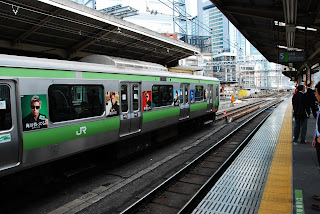 |
| Tokyo is HUGE. This is from the 26th floor in the middle of the city, and there was no end of the high-rise area visible in any direction... |
I learned a few things about how things in Japan work at this early stage:
- In a country with as many old buildings and shrines as Japan, renovation works are inevitable. What I did not expect was that instead of keeping scaffolding as subtle as possible, the building to be renovated is enveloped in a temporary building. When I got to Himeji the castle's hill was marred by an enormous (think 10-story building) factory-like abomination that had me wondering how permission to build anything like that right by the castle had ever been given. I was flummoxed to learn that this was, in fact, the castle - the main keep was completely hidden from view by this giant grey cube with an outline of the castle drawn on it. Great. Fortunately, though, the remainder of the castle was still pretty stunning!
- It is also perfectly accepted practice to rebuild ruins using modern materials in order to give visitors a spotless attraction. People seem to think that this is more important than the authenticity of what they are seeing.
 |
| Yeah. Don't really know who thought that was a good idea...the real deal must look pretty spectacular, though! |
- People will queue for everything here, and with levels of stoicism and even delight unheard of even in England. Up to 20 minutes before a train pulls into its platform, people will obediently queue - unmoving - across half the platform to where the train's doors will be (as shown by stickers on the ground). At a bus stop I saw people queueing huddled under their umbrellas in the pouring rain, not even utilising the stop's shelter.
- Comic/anime-style illustration is not restricted to children's books/art. It is utilised in maps (rendering them spectacularly useless), infographics and ads targeting every age group. The Tokyo underground's mascot is a blue anime platypus who passes out with ecstasy upon seeing the benefits conferred by the city's Oyster-card equivalent in videos played on screens in every train every minute or so.
 |
| Osaka's Pokemon Centre - frequented not just by kids... |
 |
| It left a few seconds behind schedule once. It was shocking. |
As for things we saw - Tokyo is big and diverse and interesting enough that I could easily write a post on each day we spent there...but I won't do that. Instead, I thought it'd be easier to write a little about the things that most readily spring to my mind when I now think of Tokyo. The Imperial Palace has to top the list, with the Japanese emperor as one of those quintessentially Japanese institutions. The castle itself is off limits on 363 days a year, but a stroll around the palace gardens, where the cherry blossoms were in full bloom at this point, was very pleasant. This being one of the first places we visited in Japan, we revelled in being somewhere so decidedly un-Western. Armies of immaculately clad office workers swarm the park - one of central Tokyo's woefully few green areas - at lunchtime with their chopsticks and bento boxes, which will be filled with edible goodies pleasing not only the palate but the eyes with their precise arrangement and design.
 |
| A little tranquility in downtown Tokyo |
The place was crazy - far too huge, one would think, for much order to prevail (65000 people work there), but somehow things get done. Unfortunately we didn't spot any of the gigantic knives they use to fillet the tuna (apparently they require 2 people to handle them), but weaving around the enormous processing buildings around wholesalers undoubtedly sick of tourists bumbling in the way, there were tasty things of all sorts to be seen.
 |
| The cool contraptions the workers zoom around on - the steering wheel is directly connected to the front wheel. |
 |
| Not actually taken in Akihabara, but the strange/slightly creepy mannequin seemed fitting... |
 |
| Sage advice for visiting sex shops - exhibits tend not to be edible... |
 |
| Ultra-realistic cervix - what more could a man want...? |
And just to end on yet another bizarre note, our last day in Tokyo was spent at a fertility festival which seemed mostly to pay homage to the penis. Set in a usually undoubtedly tranquil shrine, this features several gigantic phalluses which are then paraded through nearby streets - and the area is absolutely packed.
 |
| ...and so the huge pink cock begins its slow, majestic parade down the streets of Kawasaki... |
 |
| "...and they think they evolved from us..." |






















No comments:
Post a Comment